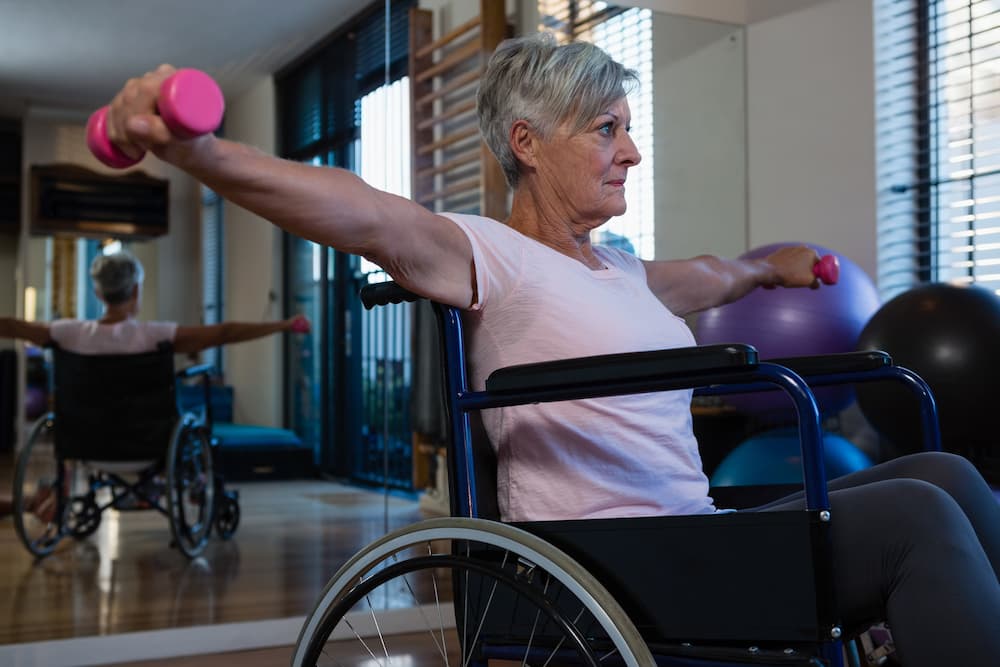Some reports show that over 2.7 million people in the United States are wheelchair users (1). Persons with disability and individuals who use wheelchairs are prone to various health complications, including urinary tract infections (UTIs). The presence of a UTI can be frustrating, and it has a significant impact on quality of life. So, how to prevent or treat it? This post focuses on UTIs and things you can do to treat or reduce the risk of developing them.
What is a UTI?
Urinary tract infection is an infection of any segment of the urinary system. This infection can affect a person’s kidneys, ureters, urethra, and bladder. However, in most cases, UTI affects the lower urinary tract, which consists of the bladder and urethra.
Different types of urinary tract infections depend on the area they affect. For example, acute pyelonephritis affects kidneys, cystitis affects the bladder, and urethritis affects the urethra.
Even though urinary tract infections were first documented in Ancient Egypt in 1550 BC, they are still among the most prevalent bacterial infections worldwide (2). As the second most common infectious disease in the body, UTI is the reason for over eight million visits to the doctor each year. About 10 in 25 women and 3 in 25 men will develop UTIs at some point in their lifetime (3).
What are the symptoms of UTI?
In many cases, urinary tract infections are asymptomatic. But, when they cause signs and symptoms, they usually include the following:
- Burning sensation when urinating
- Persistent, strong urge to urinate
- Cloudy urine
- Passing small amounts of urine frequently
- Strong-smelling urine
- Reddish, bright pink, or cola-colored urine (indicates the presence of blood)
- Pain in the pelvic area (in women)
Signs and symptoms of urinary tract infections may also depend on the type of the condition. For instance, acute pyelonephritis may cause flank pain, high fever, nausea, and vomiting. Conversely, cystitis can cause pelvic pressure, whereas urethritis may produce discharge.
What causes UTI?
Urinary tract infection results from bacteria entering the urinary tract through the urethra. Bacteria start multiplying in the bladder. Even though the urinary system is constructed in a way to keep out these pathogens and invaders, sometimes these defenses are weak and fail. As a result, infection develops.
The most common types of UTIs are cystitis and urethritis. Cystitis occurs primarily due to Escherichia coli (E. coli bacteria), usually found in the gastrointestinal tract. Other bacteria may also cause infection of the bladder. While sexual intercourse often leads to cystitis, a person doesn’t have to be sexually active to get this UTI. For example, all women risk this UTI due to their anatomy.
Urethritis occurs when bacteria from the anus spread to the urethra. Since women have a shorter urethra than men, this UTI may result from sexually transmitted diseases such as gonorrhea and Chlamydia.
Who is at risk of UTI?
Everyone can develop a UTI, but some people are at a higher risk than others. Common risk factors include:
- Being a female (due to shorter urethra)
- Sexual activity
- Menopause
- Using diaphragms as birth control
- Kidney stones
- Enlarged prostate and other blockages
- Urinary tract abnormalities
- Suppressed immune system
- Recent urinary procedure
- Catheter use, especially when not cleaned or maintained properly
Why are immobile patients at risk for UTIs?
Wheelchair users are at a high risk of developing urinary tract infections. Several factors explain why urinary tract infections are common among patients in a wheelchair. Most studies were carried out on participants with spinal cord injury (SCI). Learn more about wheelchairs and UTIs below.
Impaired urinary function
Following the spinal cord injury, most people lose normal urinary function. The incidence of UTI is lower in persons with incomplete SCI. Men and women with complete SCI, which results in paraplegia and wheelchair use, are more susceptible to urinary tract infections and other health complications.
A study showed that risk factors for UTI in patients with spinal cord injuries include invasive procedures without antibiotic prophylaxis, chronic catheterization, and cervical damage. The risk for chronic UTI increases with low functional independence and vesicoureteral reflux (4). Vesicoureteral reflux refers to abnormal urine flow from the bladder back to the ureters.
Factors that increase the risk of UTIs in patients with paraplegia and spinal cord injuries include detrusor muscle hyperactivity, i.e., increased or involuntary contractions of detrusor muscle in the bladder (5). Increased muscle activity causes incontinence due to disrupting or damaging the nerves that supply this muscle.
Impaired bowel function
Following the SCI, many people lose normal bowel function. Problems with bowel movements are widely present among wheelchair users. During bowel management, contact with stool is common.
Stool contains bacteria that cause urinary tract infections. As mentioned above, UTIs may occur when bacteria from stool reach the urethra and travels to the bladder.
Inability to empty the bladder
Bacteria are stubborn and difficult to “banish” out of the system once they settle at a specific spot such as your bladder. Instead, they start multiplying rapidly and cause infection.
People with a healthy bladder can solve this problem by emptying their bladder during urination. However, wheelchair users, i.e., patients with SCI, often can’t empty their bladder, even with adequate bladder management.
As a result, bacteria remain in the bladder, making it more prone to infections. This contributes to chronic UTIs. It’s always good to consult a healthcare provider if you cannot empty the bladder.
How to prevent or treat UTIs
Even though urinary tract infections can be frustrating and further worsen the quality of life in wheelchair users, treating them or reducing the risk of developing them is possible. We are going to focus on different UTI prevention and treatment methods below.
Caregiver education
Their caregivers play the most crucial role in preventing and managing various health complications in wheelchair users. Urinary tract infections are not the exceptions here. Caregivers who are informed and educated about a specific health aspect provide better care and support.
One study evaluated the knowledge and current practice of 30 caregivers of bedridden patients to prevent UTI. Results showed no one had adequate knowledge about this subject.
Not only was their knowledge limited, but preventative measures too. Besides recommending patients drink enough fluid, the practices to prevent UTIs were unsatisfactory (6).
Caregivers and healthcare professionals work together to provide the most suitable treatment options. Without the proper knowledge, caregivers are unable to employ effective preventative measures. Therefore, healthcare professionals must ensure patients’ caretakers are informed and educated. They can guide them through the process or recommend material they can find helpful.
Drink enough water
Staying hydrated throughout the day is essential for good health and wellbeing. Bedridden and persons who use wheelchairs also need proper hydration during the day. Drinking enough fluid has many health benefits, including:
- Flushing out bacteria
- Maintaining skin health
- Regulating body temperature
- Making it easier for stool to move through the bowel
Insufficient water intake creates fertile ground for harmful bacteria to spread. For that reason, preventing and managing UTIs requires drinking plenty of fluid. This is particularly important for people with recurrent urinary tract infections (7).
Minimal fluid intake for wheelchair users is 1500-2000ml or six to eight glasses of water. Set up reminders if you forget to drink plenty of water during the day.
Don’t let the bladder get too full
To prevent UTI or help manage this infection, a patient needs to empty their bladder when necessary. You should try to empty it entirely or as much as possible. Doing so can help patients avoid common problems that can lead to (or aggravate) UTIs. These problems include over-distended bladder and kidney or bladder stones.
Over-distended bladder happens when the bladder is stretched when holding too much urine. When that happens, the bladder wall may become damaged. Urine may flow back to the kidneys as a result.
On the other hand, bladder or kidney stones can restrict urine flow, and they’re usually painful.
Practice proper hygiene
One way to prevent UTIs and manage them is to focus on good hygiene practices. The absence of proper hygiene can pave the way to urinary tract infections due to bacteria spreading. That means patients must wash and clean before and after bowel movements, urination, and accidents. By doing so, it’s possible to limit the spread of bacteria and prevent future complications.
Take cranberry
Cranberry juice or supplements are widespread across the globe for their supposed potential to help prevent or treat UTIs. Although more research is necessary, some studies show that cranberry can reduce the risk of urinary tract infections (8). Cranberry contains proanthocyanidins compound, which may prevent bacteria from sticking to the walls of the bladder and other areas of the urinary tract. If bacteria can’t stick, you’re more likely to flush them away.
Modify your diet
There is no specific diet for the prevention of urinary tract infections. Diet isn’t an independent risk factor for frequent UTIs, but it can play a role. Some eating patterns are more beneficial than others, though. If you want to modify your diet to prevent or aid the management of UTIs, you may want to consider the following:
- Plant-based diets – eating vegan or vegetarian diets can reduce the risk of UTI and exhibit protective effects. Some foods, especially pork and poultry, function as food reservoirs for various bacteria strains, including E. coli which accounts for 65% to 75% of all UTIs. Since vegetarians avoid eating foods that act as reservoirs for bacteria, they’re less likely to develop infection of the urinary tract (9)
- Avoid certain beverages – some drinks may increase the risk of urinary tract infections. These include sodas, alcohol, coffee, artificially sweetened beverages, and even some teas.
- Increase intake of certain beverages – while some drinks may increase the risk of UTIs, others can decrease it. You may want to drink more berry juices and fermented dairy products such as dairy, kefir, and water.
- Avoid bladder irritants – to protect yourself from UTIs or manage them, it’s essential to avoid bladder irritants such as diet soda, alcohol, coffee, spicy foods, and some citrus fruits. You may identify foods and drinks that irritate your bladder. A wheelchair user, or their caregiver, should keep a food diary where they will log all foods and beverages consumed during the day. It’s also helpful to log urinary symptoms and urination.
Get some exercise
The benefits of exercise for wheelchair users are numerous. Not only does exercise help prevent pressure sores, but it also increases strength and improves blood flow. Additionally, exercise helps boost mood and improves sleep. A more robust immune system results from exercise and can help fight infections.
Although exercising in a wheelchair can be challenging, it’s all about adjusting and focusing on moves that you can perform. Wheelchair users need a physical therapist who will create a plan with exercises they can do. A caregiver can also help with exercises and maneuvers that target different muscle groups.
Do wheelchair users need a catheter?
Some wheelchair users rely on catheters because they cannot control their urine. For example, they may be unable to release or stop urine. Uncontrolled urination harms the bladder and kidneys. Therefore, adequate bladder management is necessary for keeping the urinary tract healthy. Bladder management may include intermittent catheterization, indwelling catheterization, and reflex voiding.
In this case, intermittent catheterization is utilized for draining the bladder without keeping a catheter in the bladder all the time. On the flip side, indwelling urinary catheters are utilized for ongoing protection from urinary incontinence or urinary retention. This type of catheterization relies on a catheter and a urine collection bag that stays in place.
Caregivers need to ensure a patient’s genital area and skin where the catheter tube is inserted are cleaned twice a day. When cleaning, it’s important to use soap. Replace the catheter every two weeks.
One of the essential things in catheterization is emptying the collection bag. Emptying the urine when the packet is two-thirds full (or every three hours) is crucial. Wash your hands thoroughly after emptying the pack to minimize hand contamination.
Some patients can urinate without a catheter, but they cannot drain their urinary tract properly. A catheter should be fitted when urine is backed up in these cases.
Even though there are several catheter types, evidence shows hydrophilic-coated catheters are the most beneficial for patients with UTIs. These catheters improve patient comfort and satisfaction, reduce encrustation, and lower microbial adherence (10).
Are antibiotics necessary for UTI prevention?
The primary purpose of antibiotics is to treat infections. These medications are the first line of treatment for urinary tract infections by attacking infection-causing bacteria. While antibiotics can treat UTIs, you shouldn’t use them as a prevention strategy. At least not unless your doctor says it’s okay!
These tiny organisms can adapt or change when you take antibiotics to neutralize bacteria. Plus, they may start destroying good bacteria too. In turn, they may become resistant to a specific antibiotic. That particular antibiotic becomes useful, which is why a doctor needs to prescribe a stronger alternative.
Antibiotic resistance is a problem your doctor wants to avoid, so they may not encourage you to take these medications for this purpose unless necessary.
Many people with SCI or wheelchair users need antibiotics when they start experiencing symptoms of urinary tract infections. You probably won’t get antibiotics to prevent UTIs if you don’t have a symptomatic UTI. For that reason, you shouldn’t take antibiotics that aren’t prescribed to you. When taking antibiotics, you should adhere to the recommended dosage.
FAQ
Can a UTI in the elderly affect mobility?
Urinary tract infection can affect mobility in the elderly. This infection can cause instability and increase the risk of trips and falls. Impaired mobility is an important symptom to look out for in the elderly.
Classic symptoms of UTIs, such as burning feeling, are often absent in elderly persons. It’s easy to overlook the problem and miss the infection, which can cause various complications in this age group. Besides impaired mobility in the elderly, other symptoms to look out for include confusion and incontinence.
It’s not entirely clear why UTIs can impair mobility in the elderly. Chronic urinary tract infection is associated with:
- Long-term inflammation
- Acute-phase proteins (proteins whose levels increase or decrease in the presence of inflammation)
- Increased pro-inflammatory cytokines
- Higher oxidative stress.
All these things can decrease muscle strength, muscle fatigue resistance, and mobility.
Can UTI cause the inability to walk?
When a urinary tract infection occurs, it can cause low blood pressure. A drop in blood pressure can lead to lightheadedness and dizziness. Severe UTIs may cause weak muscles and cause an inability to walk. When that happens, a patient needs assistance to stand or move. This usually affects the elderly.
Can immobility cause UTI?
Immobility can cause urinary tract infections, particularly in older men and women. Impaired urinary tract function, contact with stool, and inability to empty the bladder are among the biggest causes of UTI in this case.
Can excessive sitting cause UTI?
Excessive sitting can contribute to urinary tract infections. Studies showed that prolonged sitting and physical inactivity are strongly associated with the development of lower urinary tract symptoms. More research is necessary to elucidate the mechanisms behind this relationship (11). Sitting too much can harm the urinary tract and affect the bladder, which could explain why inactivity contributes to UTIs. This also explains why wheelchair users are prone to UTIs.
How can bedridden patients prevent UTIs?
Caregivers play an essential role in helping bedridden patients prevent urinary tract infections. As seen throughout this post, it’s critical to ensure a patient drinks enough fluid is vital. Catheters need to be appropriately cleaned, maintained, and inserted. A patient and caregiver must adhere to the doctor’s recommendations and consult a healthcare provider for all concerns they have.
Conclusion
Urinary tract infections are common among wheelchair users. When left unmanaged, UTIs can become chronic and cause problems such as kidney damage. Although wheelchair users are at high risk for UTIs, there’s a lot they can do to reduce their risk and improve their quality of life, even with recurrent UTIs. A healthy lifestyle and good hygiene are the most crucial measures. Make sure to stay hydrated, choose your foods wisely, and get a little exercise.
References
- https://www.ncbi.nlm.nih.gov/pmc/articles/PMC4397418/
- https://www.researchgate.net/publication/8136121_Management_of_urinary_tract_infections_Historical_perspective_and_current_strategies_Part_1_-_Before_antibiotics
- https://www.urologyhealth.org/healthy-living/urologyhealth-extra/magazine-archives/summer-2016/understanding-utis-across-the-lifespan
- https://pubmed.ncbi.nlm.nih.gov/10992382/
- https://journals.lww.com/pbj/Fulltext/2019/12000/Urinary_tract_infection_in_patients_with_spinal.3.aspx
- https://www.nepjol.info/index.php/JUCMS/article/view/10488
- https://www.ncbi.nlm.nih.gov/pmc/articles/PMC6988703/
- https://www.ncbi.nlm.nih.gov/pmc/articles/PMC3370320/
- https://www.ncbi.nlm.nih.gov/pmc/articles/PMC6992707/
- https://www.ncbi.nlm.nih.gov/pmc/articles/PMC4527903/
- https://www.sciencedaily.com/releases/2018/03/180321090926.htm



